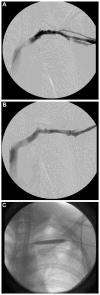Concurrent venography during first rib resection and scalenectomy for venous thoracic outlet syndrome is safe and efficient
- PMID: 26992308
- PMCID: PMC4800744
- DOI: 10.1016/j.jvsv.2014.09.010
Concurrent venography during first rib resection and scalenectomy for venous thoracic outlet syndrome is safe and efficient
Abstract
Objective: Surgical treatment of acute axillosubclavian vein thrombosis from venous thoracic outlet syndrome (VTOS) traditionally involves first rib resection and scalenectomy (FRRS) followed by interval venography and balloon angioplasty. This approach can lead to an extended need for anticoagulation and a separate anesthesia session. We present outcomes for FRRS with concurrent venography.
Methods: Retrospective chart review was performed for consecutive patients undergoing FRRS with concurrent venography for VTOS from February 2007 to April 2014. Venography was performed immediately after FRRS with the arm in neutral and provocative positions. The primary outcomes of this study were primary and primary-assisted patency. Secondary outcomes included whether concurrent venography resulted in modification of the procedure, postoperative anticoagulation use, and postoperative complications.
Results: Thirty patients underwent first rib resection with venography with a mean follow-up time of 24.4 months. The mean age was 29.5 years (range, 17-52 years), and 17 (56.7%) were female. All were maintained on anticoagulation before the procedure. Concurrent venography resulted in modification of the procedure in 28 patients (93.3%). Of these, 27 patients (96.4%) underwent balloon angioplasty and two patients (7.1%) underwent further rib resection. Twenty patients (66.7%) were discharged after the procedure with no anticoagulation. For those receiving postoperative anticoagulation for persistent minor thrombus, median time for anticoagulation duration was 5.0 months (range, 0.8 and 16.7 months). Two patients (6.7%) had postoperative bleeding requiring thoracentesis or video-assisted thoracoscopic evacuation of hemothorax. One patient (3.3%) suffered rethrombosis and was successfully lysed open, resulting in a 2-year subclavian vein (SCV) primary patency of 96.7% and primary-assisted patency of 100%. No patients required reoperation for VTOS, and all reported improvements in symptoms. Three patients (10.0%) later underwent prophylactic first rib resection on the contralateral side for symptoms and SCV stenosis.
Conclusions: FRRS with concurrent venography is a safe procedure for VTOS that allows effective intraoperative modification of the surgical plan, resulting in excellent patency of the SCV, early cessation of anticoagulation, and durable relief of symptoms.
Copyright © 2015. Published by Elsevier Inc.
Conflict of interest statement
Author conflict of interest: none.
Figures
References
-
- Hughes ES. Venous obstruction in the upper extremity. Br J Surg. 1948;36:155–63. - PubMed
-
- Sanders RJ, Hammond SL, Rao NM. Diagnosis of thoracic outlet syndrome. J Vasc Surg. 2007;46:601–4. - PubMed
-
- Brooke BS, Freischlag JA. Contemporary management of thoracic outlet syndrome. Curr Opin Cardiol. 2010;25:535–40. - PubMed
-
- Thompson JF, Winterborn RJ, Bays S, White H, Kinsella DC, Watkinson AF. Venous thoracic outlet compression and the Paget-Schroetter syndrome: a review and recommendations for management. Cardiovasc Intervent Radiol. 2011;34:903–10. - PubMed
Publication types
MeSH terms
Grants and funding
LinkOut - more resources
Full Text Sources
Other Literature Sources
Medical
Miscellaneous


